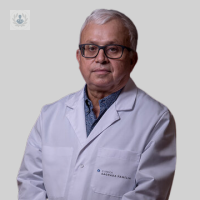Aneurysm diagnosis and best treatment
Written by:The etymology of Aneurysm Aneurysm comes from the Greek, meaning dilation. It is the enlargement of a blood vessel, reaching 2.5 to 3 times its normal or usual size.
Aneurysms can be classified into various types:• True: those with atherosclerosis and birth.• False: secondary to trauma or previous surgery aneurysms.• iatrogenic.• Mycotic or infectious.• Depending on your location can be: cerebral, aortic, mesenteric and renal vessels, or limbs.

Causes aneurysms
The causes of this expansion may be several:
• Genetic: increasingly, there are theories about the genetic component of this condition: it has been observed coincidence of families with several members who have this disorder.
• Infectious: an infection in the vessel wall may trigger an aneurysm, in these cases it is specifically mycotic aneurysm.
• Most aneurysms treating and studying the vascular surgeon of arteriosclerosis which is the origin, its etiology is impaired muscle layer of the vessel, which is responsible for this alteration. They often appear in the abdominal and thoracic aorta iliac, popliteal, and much smaller in the carotid vessels, among other locations.
Risk factors for the occurrence of aneurysms
The main risk factors for aneurysms are:
• Obesity• Arterial hypertension• Snuff• Hyperlipidemia• Age• Heredity
Diagnosis of aneurysm
These vasodilation, have a very different evolution if not treated, evolution is to thrombosis or aneurysm rupture according to their location, which is why early diagnosis is very important.
Clinically you can find a pulsatile mass on clinical examination, under the instrumental point of view, the ultrasonic means such as ultrasound and CT are the most common techniques,
Aneurysms generally do not have symptoms, so diagnosis today is by ultrasound, since in the study of renal pathology and prostate alteration is detected although it is always advisable to perform an abdominal CT scan to determine its extent.
Aneurysm treatment
Treatment is one of the most important points not forget that famous people have died from ruptured aortic aneurysm.
The first treatment date back to Rudolf Matas in the first half of the twentieth century, which starts with Alexis Carrel the first treatments, consisting of wrapping cellophane abdominal mass to cause fibrosis stop their growth or perform various ligatures, or introduction wire to cause its thrombosis. Not until 1949 that replacement of aneurysmal area arises for a prosthesis, which is the basis for subsequent treatments.
Recommended by the experts in treating vascular surgery is the replacement of the dilated area, either with the filing of a new vessel, ie making a bypass with synthetic material, or material anthologist patient 's own in most cases saphenous vein or peripheral aneurysms interposing a prosthesis is effected in the aneurysm, this prosthesis is healthy artery to healthy artery, excluding the diseased area.
The treatment of abdominal aortic aneurysms involves opening the abdomen to make this substitution, with consequent blood loss, and outstanding morbidity, so different approaches arises to decrease the various complications.
Due to the significant morbidity of this treatment in the 1990s endovascular aneurysm treatment begins, one of the promoters Parodi Argentine, who began treating aneurysms with endovascular techniques. This technique involves the introduction of prosthetic material within the vessel, with the aid of a catheter. This prosthesis and performs the same functions placed with a minimally invasive approach.
The endovascular technique in the aneurysm increasingly occupies a more important role as it allows to solve the problem with low morbidity, although it is true that not all cases can be solved well, but it can treat the vast majority of aneurysmal dilations .


